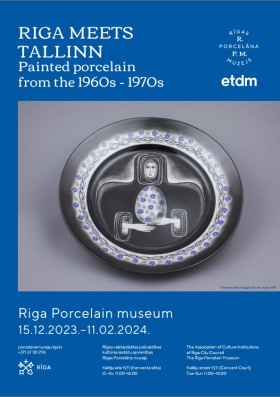-
NEWS
Exhibition “Riga meets Tallinn. Painted porcelain in the 1960s and 1970s”From 15 December 2023 to 11 February 2024, Riga Porcelain Museum hosts an exhibition from the collection of the Estonian Museum of Applied Art and Design (ETDM) about porcelain that was produced in Riga and decorated in Estonia in between 1960s and 1970s.
The exhibition “Riga meets Tallinn. Painted porcelain in the 1960s and 1970s” is dedicated to an unusual phenomenon in the history of porcelain art and manufacturing in the Baltic region – porcelain products which were made in Riga and decorated in Tallinn.
While Riga porcelain is well-known in Latvia, the story behind Riga porcelain being painted at the Porcelain Painting Workshop of the Estonian Art Products Production Enterprise (KFK – Kunstifondi kunstitoodete kombinaadid) is less familiar.
The Estonian Art Products Production Enterprise was subordinated to the Art Foundation and operated as a production conglomerate. KFK administered several specialised historic arts and crafts workshops and factories, which following the Soviet occupation had been nationalised and restructured in accordance with Soviet management principles. One of its subunits was the Porcelain Painting Workshop, established on the basis of the nationalised Nikolai Langebraun Porcelain Factory (founded in 1928).
In the 1920s and 1930s, the Langebraun Porcelain Factory did not produce many original forms, focussing instead on decorating Western European form designs. Manufacturing was geared toward consumer demand, with tea and coffee services, vases, ashtrays, snuff boxes, spice pots, candlesticks and many other items being decorated. The same principle was followed during the occupation. As there were no factories for making porcelain forms in Estonia, partially finished or undecorated vessels were imported from other parts of the USSR. Since Riga was nearby, “white” porcelain vessels were initially brought in from the Riga Porcelain Factory and the Riga Porcelain and Faience Factory, then after their merger in the 1960s from the Riga Porcelain and Faience Enterprise, and later from the Riga Porcelain Enterprise. Of course, Riga was not the only source, and vessels were also imported from other Soviet porcelain plants.Design from the two mentioned decades is at the centre of Riga Porcelain Museum’s new exhibition “Riga meets Tallinn. Painted porcelain in the 1960s and 1970s.” (Although decoration by the Estonian workshop can also be found on forms from the 1940s, the period of the independent republic and the 1980s). Interestingly, vessels decorated in Estonia could be assembled without reference to their original ensemble, for example a service might consist of various forms from Riga as well as elements from Ukrainian industry etc.
However, the aesthetic of the painting is a unifying factor. Mass production imposes strict rules on decoration, and thus porcelain decal technology was developed in Riga to allow rapid, large scale and consistent quality decoration. Conversely, in Estonia, the workshop principle gave more scope for artists to develop individual styles, creating decorations of a higher artistic and artisanal standard. Although the Porcelain Painting Workshop was tasked with decorating mass consumer goods, i.e. the decors were repeated and they were executed by both the artists themselves as well as their assistants on the basis of samples created by the artists, the human scale of the working methods produced a uniquely Estonian aesthetic.The exhibition is the first instalment of a series of possible themes emanating from the Estonian Museum of Applied Art and Design (ETDM – Eesti Tarbekunsti ja Disainimuuseum) collection. It presages further and deeper research and collaboration between Latvian and Estonian cultural institutions, enabling a better understanding of industrial cultural heritage in the private possession of Latvians and Estonians, revealing unanticipated parallels, clarifying authors and more precisely attributing objects in Latvian and Estonian museum collections.
The exhibition “Riga meets Tallinn. Painted porcelain in the 1960s and 1970s” can be viewed at Riga Porcelain Museum from 15 December 2023 to 11 February 2024.
-
THE UPCOMING EVENTS


.png)